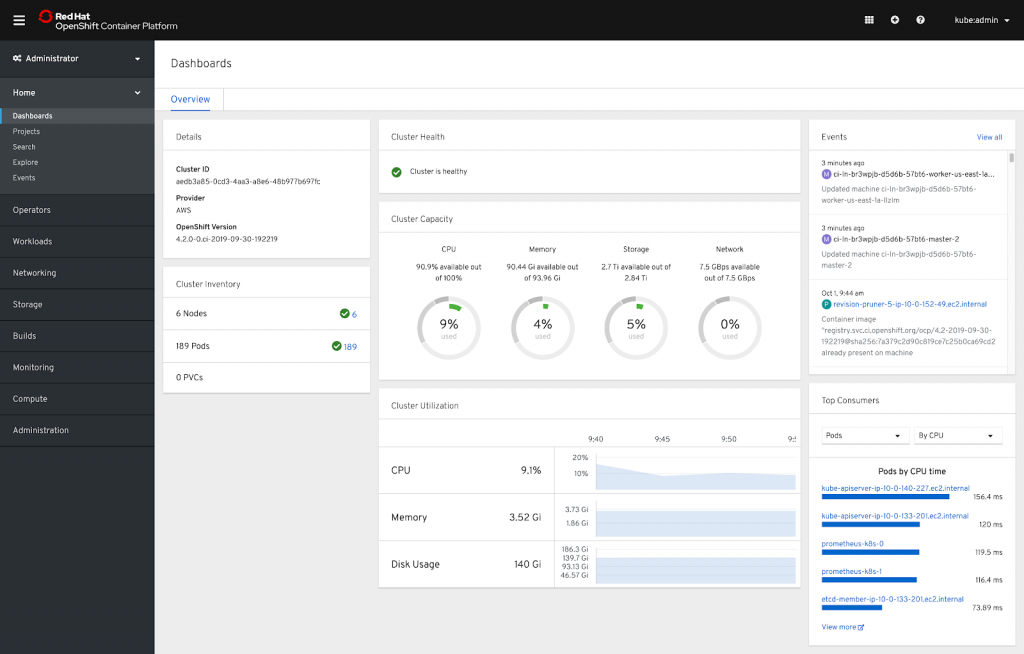In this blog post, we will jump into OpenShift, why we choose it and share our journey from OpenShift 3.2 to the present. Finally, we will conclude by explaining why OpenShift remains our tool of choice among its competitors.
“Tool of Choice” is a series of blogpost that describe battle-tested, enterprise-grade tools and processes that we offer to all our customers – providing installation, configuration, support, and enablement for.
What is OpenShift?
OpenShift Container Platform is a Kubernetes-based platform developed by Red Hat that manages containerized applications. It extends Kubernetes with additional features such as developer tools, integrated CI/CD pipelines, and enterprise security. OpenShift simplifies the deployment, management, and scaling of applications, making it an attractive option for organizations looking to streamline their operations and accelerate their development cycles.
Key Features of OpenShift Container Platform
- Kubernetes Integration: Built on top of Kubernetes, provides scalable management of containerized applications
- Developer Experience: OpenShift offers tools like OpenShift CLI (oc), Source-to-Image (S2I), and integrated developer environments.
- Operational Efficiency: monitoring, logging and application lifecycle management which enchance reliability.
- In Place Upgrades: builds on Operation Efficiency, which ensures minimied downtime
- Security: Built-in security features including enhanced container isolation, role-based access control (RBAC), egress firewall and network policies
- Scalability: Ability to scale applications both horizontally and vertically to meet varying demands.
Why OpenShift?
Capabilities that were included for such criteria were Container Infrastructure, Managed Provisioning and Updates, Platform Engineering Support and Application Platform Capabilities.
OpenShift Container Platform provides enterprise-grade management of container both on premise and in cloud. Its straightforward interface and suite of additional tools make Kubernetes easier to manage.

Additional benefit is its support for multiple programming languages, frameworks and deployment options which makes it suitable for diverse environments.
- Provides DevOps capabilities to accelerate delivery by including integrated CI/CD pipelines and developer tools which streamline development process.
- Offers robust security features that help organizations meet compliance requirements and comes with extensive enterprise support, ensuring that critical systems remain operational.
Our Journey with OpenShift
Our initial journey started with Kubernetes back in 2015 where we recognized the opportunity in the market and started researching around Kubernetes. That translated to our Journey with OpenShift, which began in 2016 with the release of OpenShift 3.2. At the time, due to its simplicity in installation it enabled us to quickly engage with the environment with minimal changes. OpenShift streamlined installation process, where some other platforms required configuration of network and storage plugins.
The decision to adopt OCP was additionally influenced by the requirements to improve and speed up deployment cycle. Not long after, some of our customers started conversations around Kubernetes and microservices and that started our OpenShift and platform setups for our customers. Additionally the tool was driven by Red Hat, where they provided support and educational resources.
Starting with OpenShift 3.2
The initial setup had a steep learning curve, but the benefits were quickly visible. With additional onboarding of pipelines, application development and deployment became smoother and quicker.
Transition to OpenShift 4
The release of OpenShift 4 brought significant improvements. Most notable ones are straightforward installation process, which enabled use of OpenShift installation program. Support of Operators as a method of packaging, deploying and managing Kubernetes applications. The transition provided us with greater stability, security, and scalability.
Case Studies: Success Stories with OpenShift
Until now, we’ve successfully implemented OpenShift for more than 20 customers, each with unique needs and challenges. Our teams implemented Internal Developer Platform across these organizations, which made the adjustment to new additional processes smoother. We led modernization initiative to keep up with current technology trends and one of these was migrating from OpenShift 3 to OpenShift 4. The transitions were done with minimal distruption to the services. Implementation of OpenShift improved operational efficiency and service delivery to our customers.
Here are some of our success stories:
Conclusion
Choosing the right platform for container orchestration is critical, and for us, Openshift Container Platform has proven itself to be the ideal choice. It stands out for its robust features, flexibility, focus on security and enterprise support. Pairing it with other tools, such as ArgoCD significantly increased resillience of our infastructure, improved our service delivery, development lifecycle and customer satisfaction. Ours and infrastructure of our customers is more resillient.

Openshift is not just a tool, its a comprehensive solution which ability to simplify complex processes makes it our tool of choice in the world of container orchestration platforms.
Have a question or need help with setting up your internal platform?
Contact [email protected]
Falls Sie Fragen haben, sind wir nur einen Klick entfernt.



